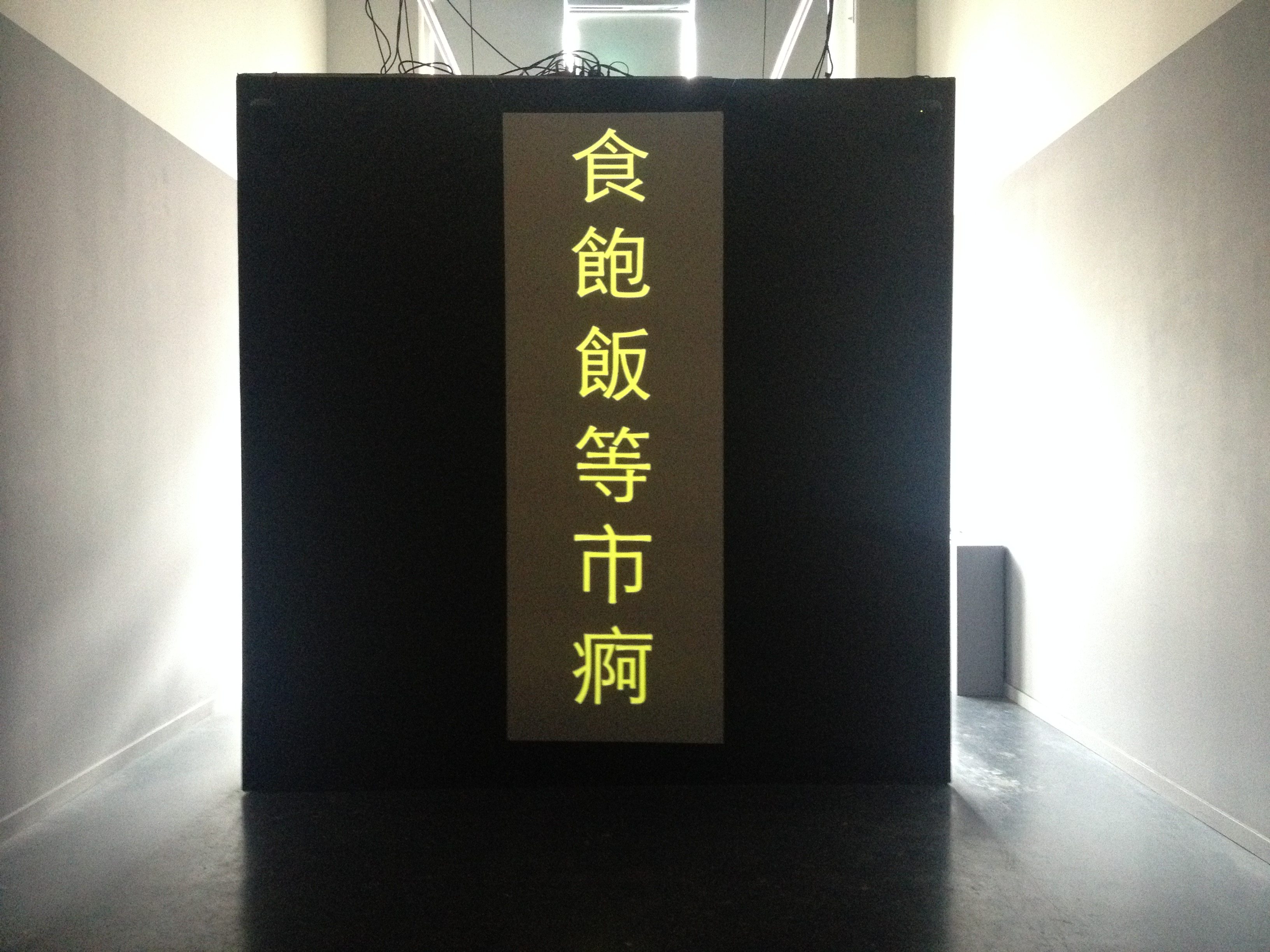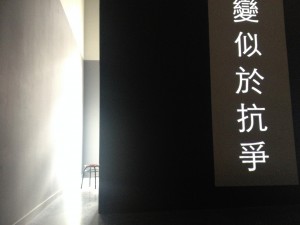Tension, Translation, and Tone: A Review on Transgression/Cantosphere
ENGL 464K Writing Assignment #2
Kay (Katherine) Ho – 65272130
Centre A’s Transgression/Cantosphere exhibit sits in one of the lonelier streets of Vancouver’s Chinatown. The exhibit is in a small, rectangular room, with muted tones lit by dim light. A solid black wall bars two-thirds of the room; on the other side is a long rectangular projector screen, a wooden shelf of various Western beauty products, and a single sentence lining three sides of the grey room. A soundtrack of a mechanized female voice plays as Chinese characters flash on the projector screen. The aesthetic is simple, yet jarring.
Chinatown has long been a contact zone between Chinese, Indigenous, and white communities. As with many cultural/ethnic spaces in North America, Chinatown holds an ongoing tension between marketability and preservation of culture. The Transgression/Cantosphere is an incisive commentary on the ways in which urbanization, gentrification, and Mandarinization affect Chinatown’s authenticity.
The placement and aesthetic of the objects in the exhibit is intentional and poignant. For example, the expensive, frivolous beauty products are unobtrusively placed at the back of the room, acting as a haunting reminder of the “hipsterization” and “white-washing” of Chinatown by a non-Chinese Western elite. As well, the words along the walls are clustered together, creating a sense of suffocation. This compels viewers to think about the ways in which condo development and “renovictions” continue to encroach on Chinatown.
Much of the exhibit’s focus is on language. Transgression/Cantosphere uses Mandarin as a motif of the capitalist pursuits of mainland Chinese developers, whose aims to build condos occur at the loss of Chinatown’s Cantonese-speaking culture. Just as Theresa Cha plays with language and uses line breaks, gaps, and pauses in Dictee, the exhibit replaces Chinese words with phonetically similar counterparts of different tones. By using subtle measures to create new meanings, Transgression/Cantosphere compels us (viewers) to rethink the ease with which we engage with language. Language, after all, confers power and privilege, and the Mandarinization of Chinatown reflects the ways in which developers and condoists are growing in dominance. Many of the new sentences, therefore, act as critical commentary on the theme of culture and authenticity. For example, the sentence “hope is in the people” becomes “hope is in the questions that people ask.” Perhaps the artists are suggesting that questions, critiques, and interrogation (and by extension, rallies, demands, and protests) are all necessary to preserve Chinatown’s culture.
It is important to note here that these sentences are all translated from Chinese to English. This plays with the tense relationship between betrayal and faithfulness. What is lost in this translation? What is untranslatable? What new meanings are created? Although the exhibit does not explicitly answer these questions, it prompts viewers to reflect on how our different social locations (and fluencies with different languages) affect the ways in which we can/not engage with the exhibit. Given the diversity of Vancouver, and the diversity of viewers that will likely attend the exhibit, this is a potent reminder of the effects that multiculturalism has on different cultures, and the attendant losses, alterations, and changes it can bring.
The mahjong table near the door is the last piece that viewers encounter. Placed on the table are four headphones, from which a soundtrack plays. In the soundtrack, a native English speaker attempts to learn the different tones in Cantonese, while a teacher encourages him in a mix of Cantonese and English. The sometimes fluid, sometimes disruptive mingling of the two languages embodies the tensions and themes seen in the exhibit, and echoes into the wider streets of Chinatown.
WC: 583
References:
“Current Exhibition.” Tyler Russell. Centre A. Centre A, 10 March 2015. Web. 13 March 2015. <http://centrea.org/exhibitions/current/>.


